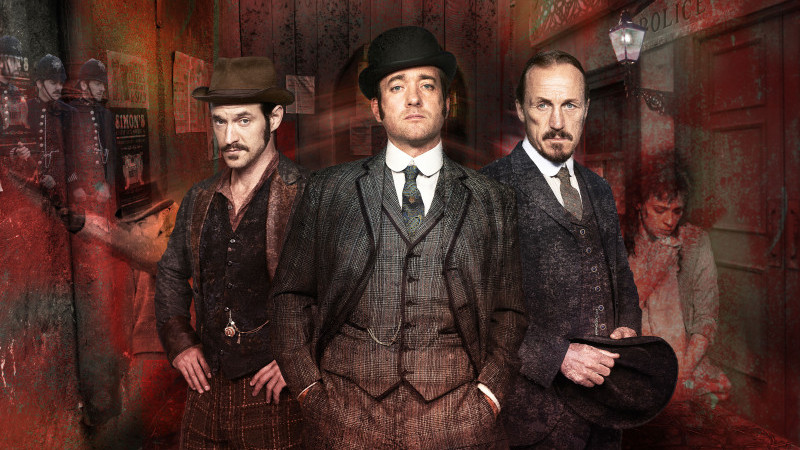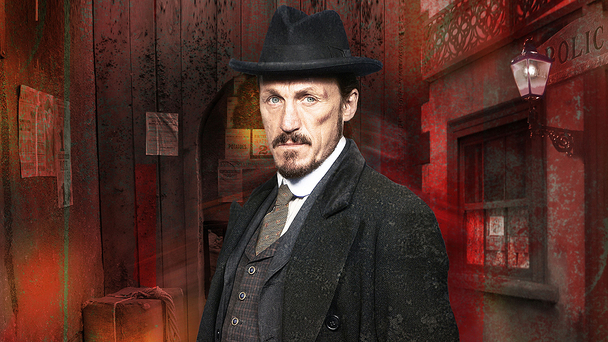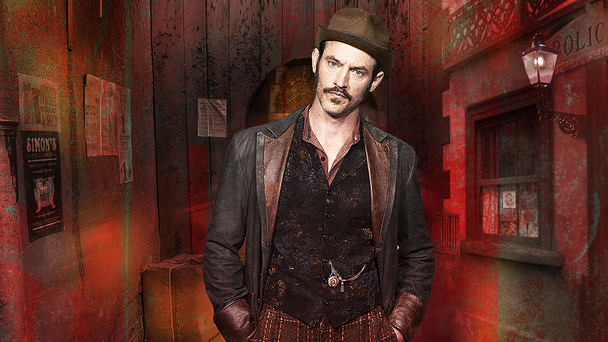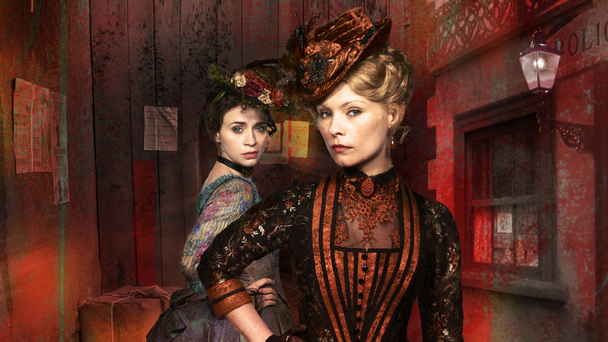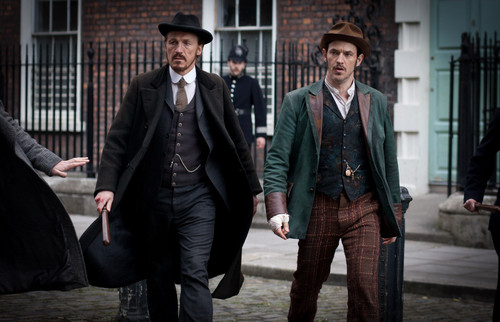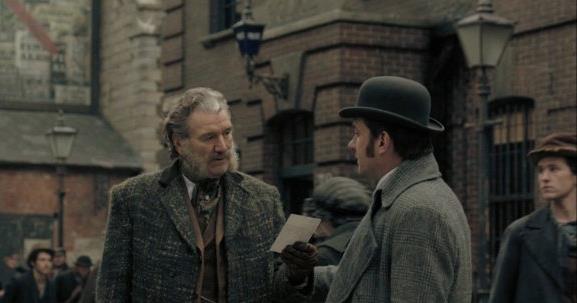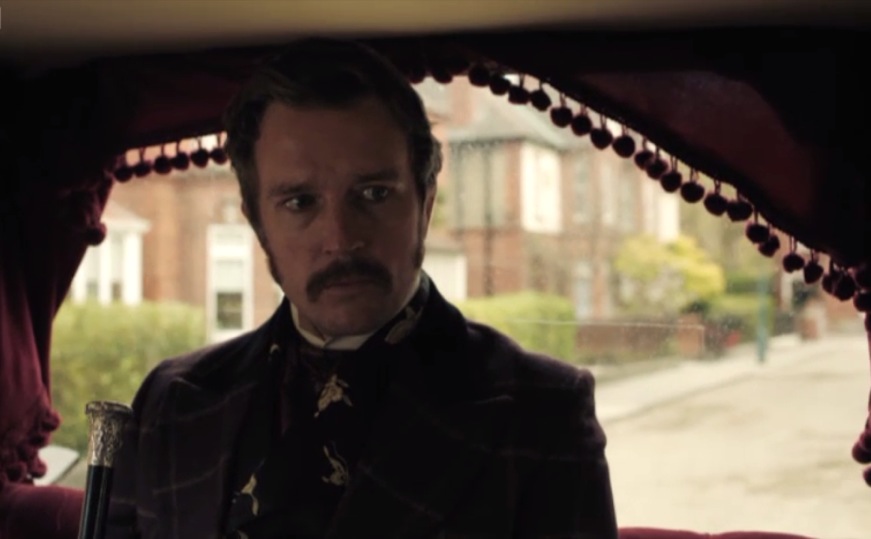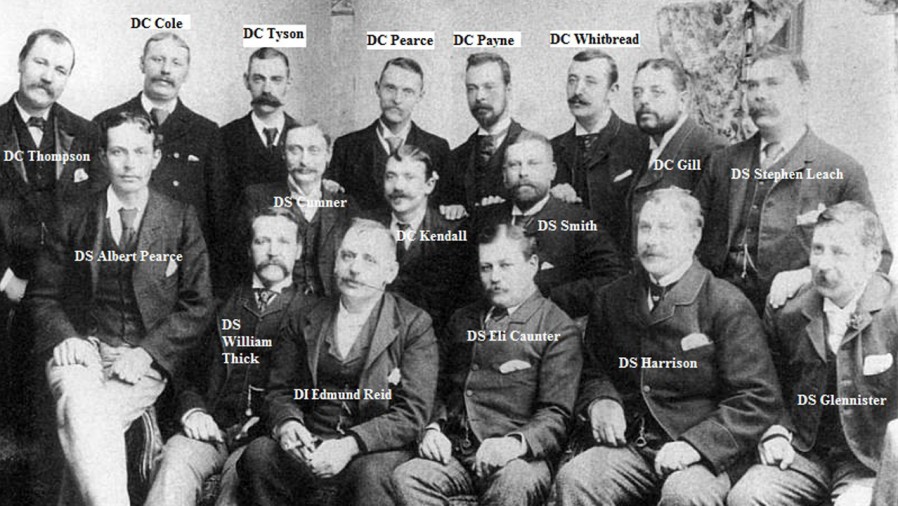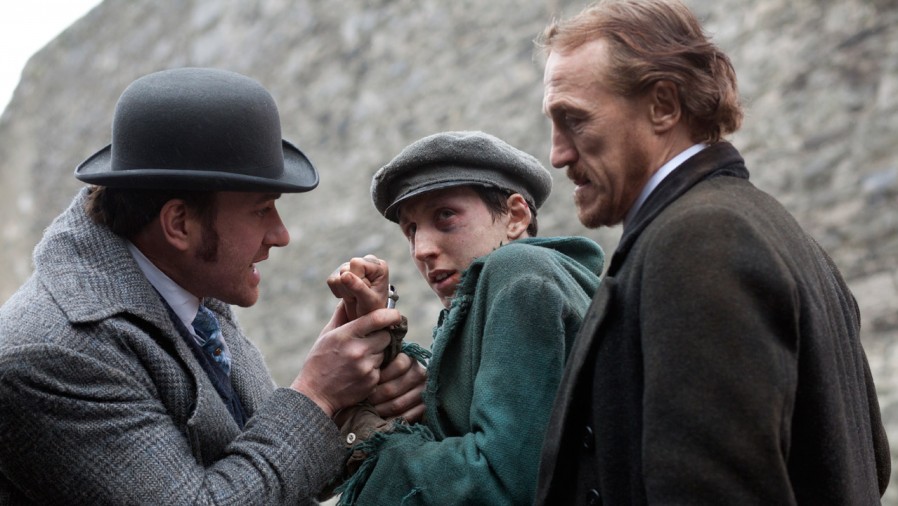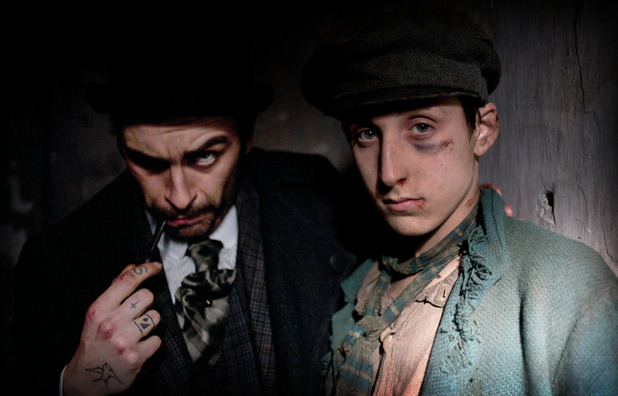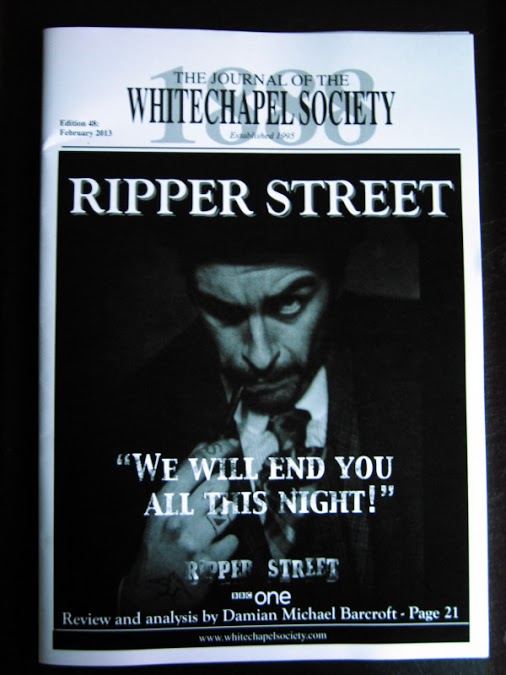RIPPER STREET
“Ladies and gentlemen, welcome to Whitechapel…”
by Damian Michael Barcroft
“As the sun sets over the Olympics, darkness rises on Ripper Street”
On Thursday, 9th August 2012, I was contacted by Iain McCallum, the head of Press and PR at Tiger Aspect Productions about my helping to promote one of their new television series entitled Ripper Street. This was on the eve of the launch of their teaser trailer for the show which was going live the following day on the internet and set to screen on BBC One that evening and over the weekend. More than happy to oblige (they had me at the first word of the title!), I set my alarm for the next morning just before six and posted the link via my twitter account and was astonished by two things. Firstly, I was impressed by the stylish and unique promotional trailer, and secondly, I could not believe the reaction it had on the internet and the amount of interest it generated with many people tweeting me throughout the day (and the weeks and months that followed!) asking when the series was going to be broadcast. Alas, I was not privy to such information, indeed neither the BBC or Tiger Aspect knew at that particular point in time, but it illustrates the increasing power of social media.
.
The trailer begins with a bird’s-eye view of the skyline of contemporary London with the Olympic stadium framed at the centre of the screen. The camera tilts down through increasingly dense clouds and we find ourselves in the dark and moody backstreets of Whitechapel where a mysterious figure is being chased by three other men as the soundtrack plays Kanye West and Jay-Z’s No Church In The Wild and the voice-over proclaims, “As the sun sets over the Olympics, darkness rises on Ripper Street”. It was a great idea to incorporate the passion and success of London 2012, juxtaposing such an iconic and British celebration with another historical event, albeit one that is far more grim and less a source of national pride. Despite lasting less than a minute and showing very little of any actual footage from the series, the trailer must surely be one of the most creative and inventive in recent memory. I was also provided with the following official series synopsis which appeared in many newspapers, magazines and websites over the days and weeks that followed:
.
“April 1889 – six months since the last Jack The Ripper killing, East London is emerging into a fragile peace, hopeful that this killer’s reign of terror might at last have run its course. Nowhere is this truer than in the corridors of H Division, the police precinct charged with keeping order in the chaos of Whitechapel. Its men hunted this maniac; and failed to find him.
.
Ripper Street is their story. A police procedural set in the teeming streets of the East End as it moves into the last decade of the 19th Century. H Division was responsible for policing a relatively small area of just 1¼ square miles, yet into that space were packed some 67,000 people; a seething, bustling mass of the poor and dispossessed.
Ripper Street is their story. A police procedural set in the teeming streets of the East End as it moves into the last decade of the 19th Century. H Division was responsible for policing a relatively small area of just 1¼ square miles, yet into that space were packed some 67,000 people; a seething, bustling mass of the poor and dispossessed.
.
Between the factories, rookeries, chop shops and pubs that mark out this maelstrom moves DETECTIVE INSPECTOR EDMUND REID (Matthew Macfadyen) – a forward thinking detective haunted by a tragic past mistake. Accompanied by the ever loyal local brawn of DETECTIVE SERGEANT BENNETT DRAKE (Jerome Flynn) and the mercurial brilliance of the U.S. Army surgeon and one-time Pinkerton detective, CAPTAIN HOMER JACKSON (Adam Rothenberg), Reid seeks to bring justice and the rule of law to a world that is forever on the brink of mayhem. Ripper Strret is not another backward-looking ‘Hunt the Ripper’ story, but a fictionalised trek into the heart of a London borough living in the blood soaked aftermath of that forever anonymous killer. It is an investigative procedural about dedicated policeman for who life – and crime – go on.”
Between the factories, rookeries, chop shops and pubs that mark out this maelstrom moves DETECTIVE INSPECTOR EDMUND REID (Matthew Macfadyen) – a forward thinking detective haunted by a tragic past mistake. Accompanied by the ever loyal local brawn of DETECTIVE SERGEANT BENNETT DRAKE (Jerome Flynn) and the mercurial brilliance of the U.S. Army surgeon and one-time Pinkerton detective, CAPTAIN HOMER JACKSON (Adam Rothenberg), Reid seeks to bring justice and the rule of law to a world that is forever on the brink of mayhem. Ripper Strret is not another backward-looking ‘Hunt the Ripper’ story, but a fictionalised trek into the heart of a London borough living in the blood soaked aftermath of that forever anonymous killer. It is an investigative procedural about dedicated policeman for who life – and crime – go on.”
Episode 1: I Need Light
Written by Richard Warlow and directed by Tom Shankland (Originally broadcast: Sunday, 30th December 2012, 9-10pm on BBC One)
.
“Ladies and gentlemen, welcome to Whitechapel”, a tour guide barks as he takes a group of curious thrill seekers, and thus us – the television audience, into the dark and foggy streets of London’s East End to explore the scenes of the crimes of a man we know only as Jack the Ripper. It is 1889 and six months have passed since the horrific murder of Mary Jane Kelly, the last of the five canonical victims and not long after reaching Miller’s Court, the unthinkable has happened – there’s been another murder! The Ripper has struck again – or has he?
I would defy any member of the audience, particularly Ripperologists, not be hooked within the first few minutes of Ripper Street, the new eight-part BBC series made in collaboration with BBC America and Tiger Aspect Productions. This pilot episode is a rare treat, a show that not only fulfills expectations but exceeds them and delivers more than simply thrilling entertainment. Furthermore, one might be so bold as to describe it as a postmodern pastiche in that there are familiar elements such as authentic Victorian characters and history but juxtaposed with fictional and contemporary narrative structures and devices such as the police procedural drama, serial killer thrillers and other related characteristics of the genre. Indeed, Ripper Street could well have been accompanied by the subtitle of CSI – Victorian London.
.
It is no exaggeration to say that the whole production looks like a multi-million-dollar Hollywood film, the production design and photography is simply stunning and the Dublin sets are the most visually impressive (albeit hardly historically or geographically accurate) recreations of Victorian Whitechapel since the Michael Caine miniseries,Jack the Ripper (1988) or From Hell (2001). However, even greater than all of this is the excellent cast which range from established television stars to supporting players and character actors who more than compensate for the arguably inevitable weaknesses of a show with such scope and ambition.
It is no exaggeration to say that the whole production looks like a multi-million-dollar Hollywood film, the production design and photography is simply stunning and the Dublin sets are the most visually impressive (albeit hardly historically or geographically accurate) recreations of Victorian Whitechapel since the Michael Caine miniseries,Jack the Ripper (1988) or From Hell (2001). However, even greater than all of this is the excellent cast which range from established television stars to supporting players and character actors who more than compensate for the arguably inevitable weaknesses of a show with such scope and ambition.
One of the major criticisms is the derivative way in which it emulates the two recent Guy Ritchie Sherlock Holmes films, particularly the title sequence, music score and the second scene in the episode with the bare-knuckle boxing, especially the choreography and editing, in which we are introduced to two of the main characters, Detective Inspector Edmund Reid (Matthew Macfadyen) and Detective Sergeant Bennett Drake (Jerome Flynn). Furthermore, one might also accuse the writer of borrowing liberally from not only Victorian historical fact, but also from the fictional works of Sir Arthur Conan Doyle, Charles Dickens and Robert Louis Stevenson to name but a few authors of the period. Another potential problem is the narrative structure which is not as tight and economical as it could be, leading to overlong scenes and a great deal of unnecessary exposition, especially when we are so rapidly introduced to yet another central male character, Captain Homer Jackson (Adam Rothenberg) resulting in some sort of “bromantic” threesome that could be in danger of becoming both superfluous and slightly annoying but time and the following episodes will hopefully prove me wrong.
However, it must be said these flaws or shortcomings are a small price to pay for a series that is clearly going to be brave and controversial and I am determined to celebrate the many positives especially when one considers the amount of mind numbing entertainment that usually masquerades as entertainment on BBC One and rival channels. Perhaps one of the most pleasing aspects is the way in which the programme constantly mentions and references events, people and places from Victorian London. From Gladstone to the expansion of the London Underground, photography and the fledgling cinema industry, identifying possible similarities between the first victim of the show (Maude Thwaites played by Sarah Gallagher) and the canonical murders – there is much to enjoy, especially for Ripperologists, not least the inclusion of a certain Chief Inspector Frederick Abberline (Clive Russell). As much as I adored Michael Caine’s take on the role, we were always aware that it was Caine the movie star that we were watching and not his character, (the less said about Johnny Depp the better!), so Russell’s portrayal has the potential in later episodes of becoming the definitive screen representation of Abberline and despite the fact that there are no definite photographs of the man, this incarnation is the best fit of how I imagined him to look from surviving pen-and-ink portraits.
I’m not going to recapitulate the plot for several reasons, namely that much of this has been covered in the series synopsis above from Tiger Aspect, most of the readers will surely have seen the episode anyway and finally, I should not wish to spoil the story for anyone that hasn’t. However, I would like to draw your attention to some of the performances in the aforementioned stunning ensemble cast. While the three main male characters are wonderfully cast and deliver performances of both credibility and charisma (I’m sure the earnest and wholesome Macfadyen will be a particular hit with female members of the audience or perhaps Flynn will also delight should they be in the mood for a bit of rough!), I was far more interested and impressed by the supporting cast most notably Jonathan Barnwell as the young and quietly courageous PC Dick Hobbs, MyAnna Buring as Long Susan – the feisty madam in charge of an incredibly respectable-looking brothel and Charlene McKenna as the young prostitute Rose Erskine – an incredibly difficult role given what her character has to endure throughout the episode’s climax (you know what I’m referring to if you’ve seen it) but she manages to pull it off with dignity and an innate empathy for the part. Finally, in a role which could have easily descended into the hammy and melodramatic, Mark Dexter impresses as Sir Arthur Donaldson with a subtle and nuanced performance remaining still and silent for most of his short screen time but his haunting eyes tell a very different story and portray an inner evil and perversity. Dexter is a prolific actor who has appeared onscreen in a variety of successful television shows including Doctor Who, The Bletchley Circleand Silent Witness but I’m sure many readers will mostly remember him as Prince Edward Albert Victor in From Hell.
Some of the most enjoyable moments were those that were simple in nature but all the more effective because of it. The props department should be applauded and I loved the little touches such “Dr. Jackson’s Topical Remmedy” medicine bottle in Cpt. Homer Jackson’s room which was positioned in such a way that only the part of the label was visible – “Dr. Jack…”. I was also pleased to see many authentic replicas of Victoriana including the original Jack the Ripper crime scene and autopsy photographs. The highlight however, must surely be the Star journalist Fred Best’s (David Dawson) office with numerous framed newspaper covers depicting the Whitechapel murders and various Ripper suspects. It is lovely touches such as these that will delight Victorian enthusiasts and serve as such an effective contrast with the more dramatic and explosive scenes such as the one in which Reid, Drake and Jackson are trapped inside a photography laboratory that is engulfed in flames.
With the inclusion of so many real life characters in the episode such as Reid (1846-1917), Abberline (1843-1929) and Best (b. c. 1858), there will no doubt be purists in the audience who will grumble at its historical accuracy but this is to miss the point entirely. The concept for the show was never be a history lesson about Whitechapel or even pursue the idea of Jack the Ripper and his actual identity. Instead, the writers have chosen a “what if” scenario in which to explore and tell stories about how the murders affected the community and the police who failed to protect them and apprehend the killer. Indeed, I would argue that by freeing themselves from the constraints of historical accuracy and complex Ripper lore, the dramatists have the opportunity to explore (in this and later episodes) not just serial murder, but also pornographers, child gangs, slum landlords, vigilantes and anarchists – all of which are still very much relevant to today’s society and problems.
Surely the true test of any first episode of a new series is to ask yourself, do you want to continue watching and learn more about its characters? Consider the character of Reid, haunted and scarred by not having captured the Ripper and we learn his scars are physical too in a scene in which he undresses to reveal terrible burns across his back. Additionally, we are also tantalized and teased by wondering what is the back story of Drake – hard as nails but with a heart of gold and fiercely protective of the younger coppers such as Hobbs, and finally, what exactly is the relationship between Jackson and Long Susan? All will no doubt be revealed, and I for one can’t wait for the next opportunity to peer around the corner and into the shadows of the dark and bloody Ripper Street.
.
*
.
“The most significant reinvention of Victorian iconography since the BBC’s Sherlock”
.
Episode 2: In My Protection
Written by Richard Warlow and directed by Tom Shankland (Originally broadcast: Sunday, 6th January 2013, 9-10pm on BBC One)
It was difficult to know exactly what to expect after the first episode – would there simply be more dead bodies of women found in the backstreets of Whitechapel, more monstrous men manipulating and exploiting women? Instead, the second episode took an entirely different and surprising direction, the resulting story being far more involving with the characters really beginning to establish strong characterisations and chemistry with each other and much more fascinating back story revealed making this a truly great ensemble cast.
.
Drake continues to identify with and protect the younger characters which really brings another sympathetic dimension to his hard man role. The troubled relationship with Reid and his wife is explored further revealing that Jack the Ripper was not the only mystery to give him sleepless nights – there is also the disappearance of his daughter, a subplot that is beautifully brought to life when he reluctantly tucks one of the little girls into bed at the orphanage. Jackson develops his contradictory and complex character with his prostitutes and gambling, essentially becoming both part of and a solution to many of Whitechapel’s troubles.
.
.
Many new and exciting characters are also introduced, most notably Joseph Gilgun as the terrifying Carmichael, a creation truly worthy of being a Dickensian villain (indeed, he is almost a hybrid of Fagin and Bill Sykes and the story does often echo and parallel the themes of Charles Dickens’ Oliver Twist) who recruits young boys in order to groom them into carrying out his dark deeds such as Thomas Gower (played exceptionally well by Giacomo Mancini). The scenes with Carmichael and his child gang (almost a evil and sickening opposite to Sherlock Holmes’ Baker Street Irregulars) are not only disturbing but also eerily evocative of recent events with the London riots. Perhaps most interesting of all though, is the inclusion of yet another historical character so important to the the world of Ripperology – President and chairman of the Whitechapel Vigilance Committee, George Lusk (1839-1919) played by the always watchable and reliable Michael Smiley.
The episode boasts many memorable scenes such as the hanging at the gallows, the fight between Long Susan and Carmichael at the gambling house and Reid’s final confrontation with the child gang at the Jewish Orphanage. Indeed, one could argue that there is actually too much going on with little time in between to digest the set pieces and the many frustratingly leading lines, for example Long Susan to Jackson: “You forget who we are, what we have done” and the mystery surrounding the ring that he gambled away to Carmichael.
.
On the evidence of the first two episodes at least, it may not be the perfect series but then so few are. There are times when the dialogue is either inaudible or simply not in keeping with the period, the main story arc and subplots often appear overburdened with such a cast of characters – so much so that it is frequently detrimental to the overall cohesion of the main plot and how the characters interact and relate to one another. However, I believe it to be the most significant reinvention of Victorian iconography since the BBC’s Sherlock and if it inspires the next generation of Ripperologists and Victorian historians to visit their libraries, dusting off old books and examining newspapers and documents, then this will perhaps be the shows greatest achievement of all.
.
*
.
Next time on Ripper Street…
.
So what can we expect in the future from Ripper Street? Well, despite the BBC receiving almost 90 complaints due its alleged graphic violence and negative portrayal of women, the pilot episode attracted a very respectable 6.1 million viewers and an industry insider has revealed to me (tell no one!) that a second series has already been commissioned with filming beginning as early as April.
.
.
In response to some of the negative publicity which dominated many newspaper and website columns in the New Year, I would argue that it is as unfair as it is inaccurate. Indeed, there is far more violence to be found in other prime time shows, particularly those imported from America and it is the fact that the programme dared to appear in a Sunday-night slot that is traditionally reserved for productions such as Downton Abbey and the like. Had Ripper Street been purely an American production, not made by the BBC at all and neither appeared on a Sunday night or over the sacred Christmas holiday period, I doubt anyone would have even raised an eyebrow. Yes, there were some disturbing scenes and the female characters may conform to Sandra Gilbert and Susan Gubar’s The Madwoman in the Attic (The 1979 study which examines Victorian fiction from a feminist perspective exploring the notion that female characters either embody the image of “angel” or “monster”) stereotypes but this was Victorian England during the aftermath of one of the most horrific series of crimes the world has ever known – what were they expecting from a show called RIPPER Street?
.
.
*
.
I would like to sincerely thank Iain McCallum, Sophie Appleton and all the gang at Tiger Aspect Productions for the promotional materials they kindly sent to me and for all their help and support. Cheers guys!
.
.
*
.
This article was originall published in The Whitechapel Society Journal – Edition 48: February 2013 for subscription details and back issues, please see http://www.whitechapelsociety.com/
